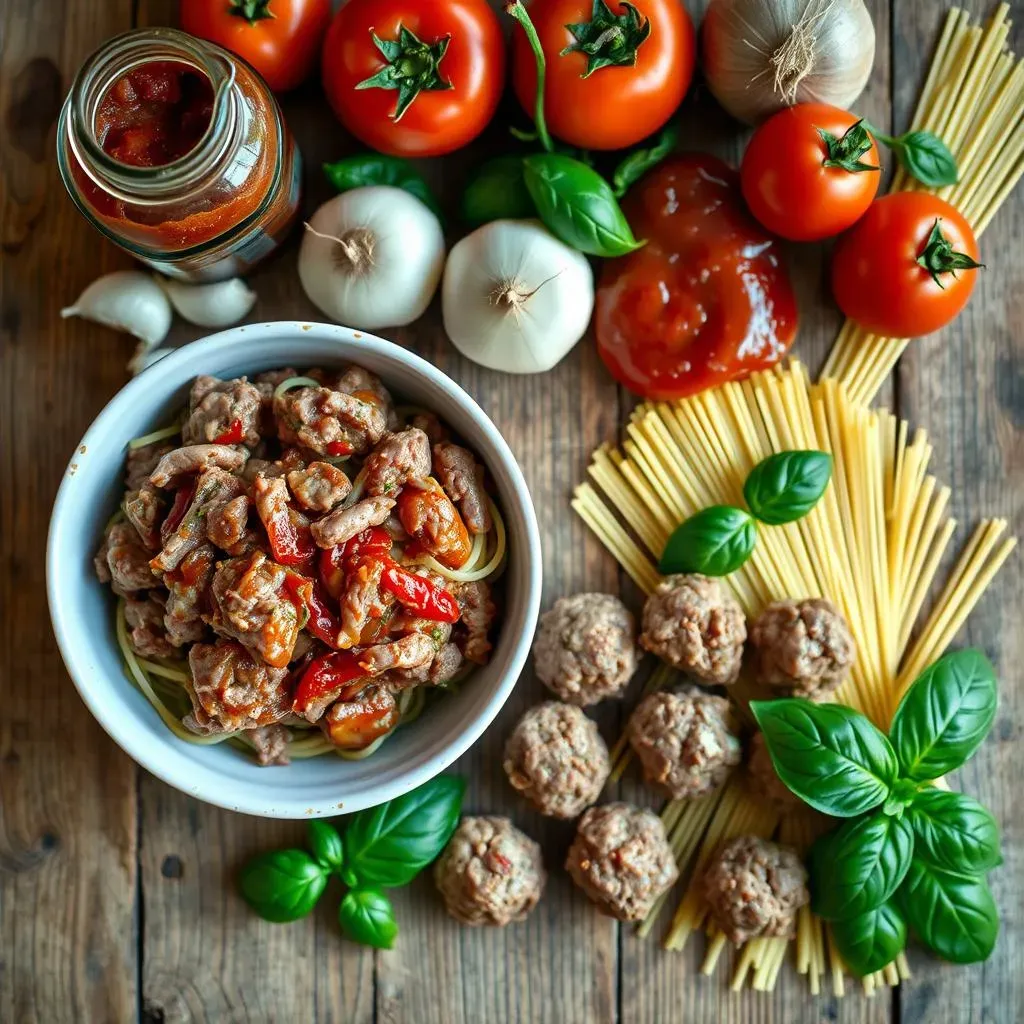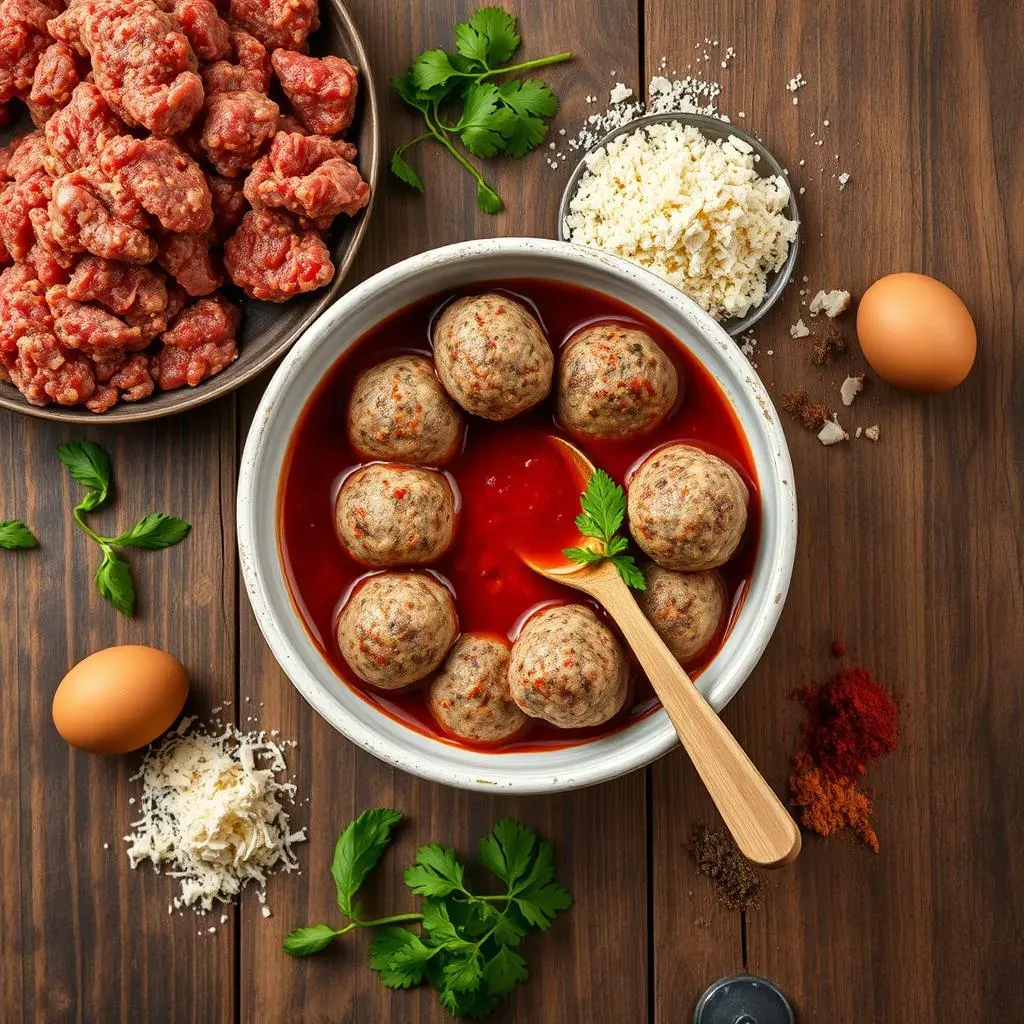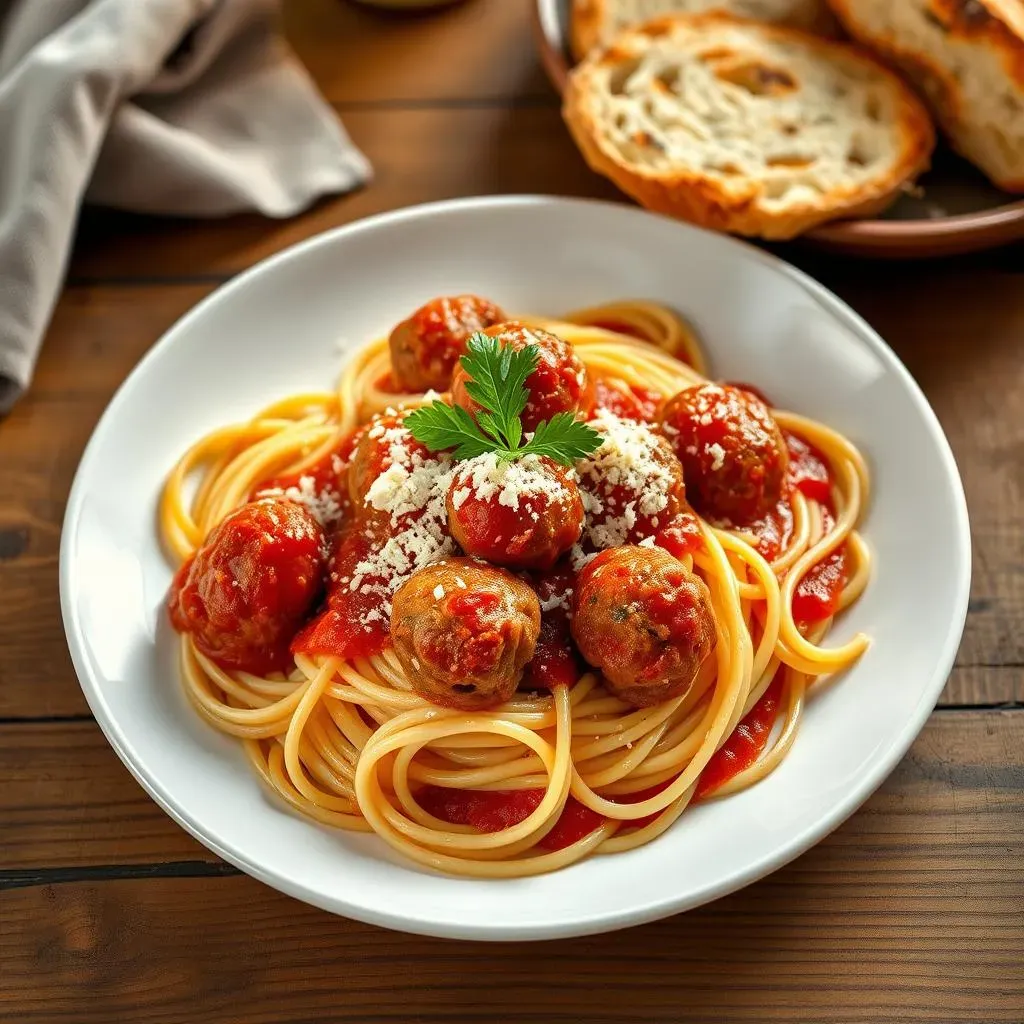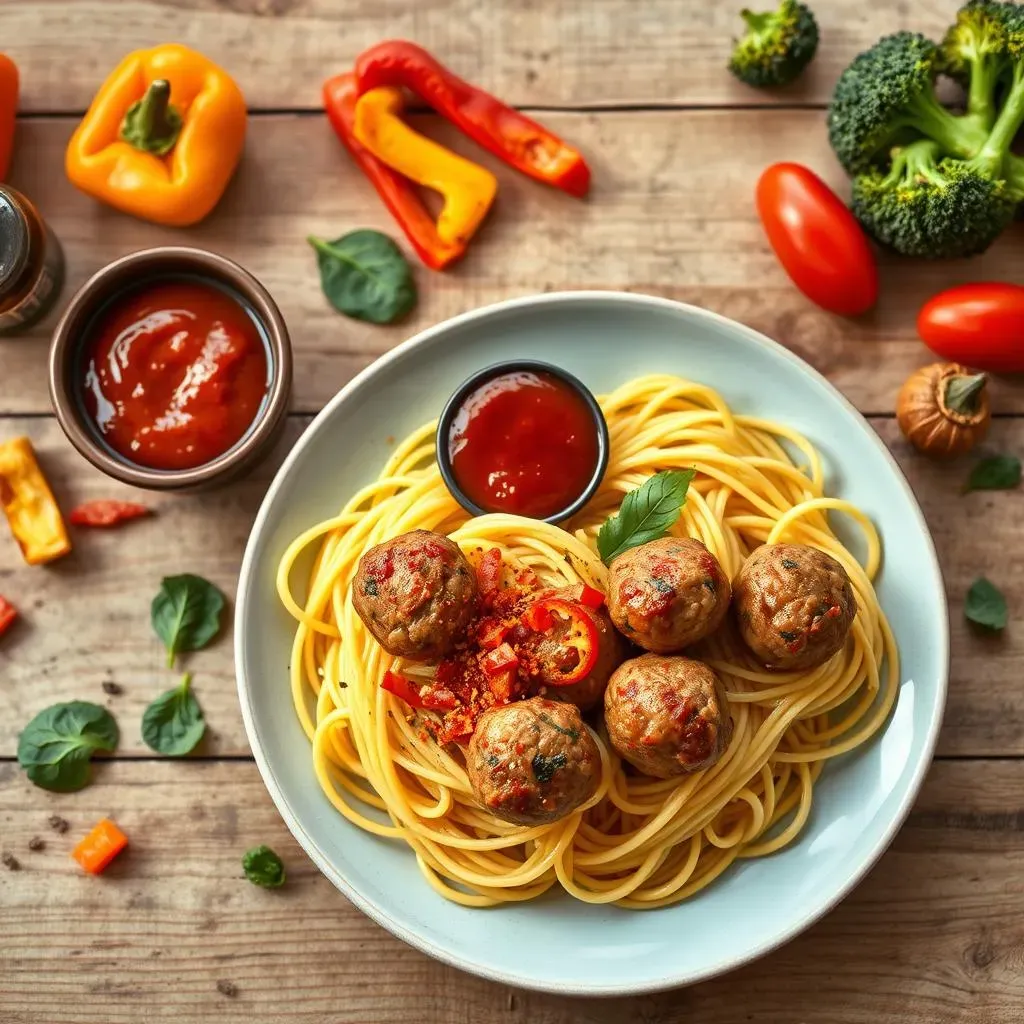Who doesn't love a big plate of spaghetti and meatballs? It's a classic comfort food dish that brings back memories of family dinners and cozy nights in. But sometimes, the thought of making it from scratch can feel a little daunting. That's where this spaghetti and meatballs easy recipe comes in! We're going to break down the process into simple, manageable steps, so you can whip up a delicious and satisfying meal without spending hours in the kitchen.
Mastering the Basics: Ingredients for Your Spaghetti and Meatballs Easy Recipe

Mastering the Basics: Ingredients for Your Spaghetti and Meatballs Easy Recipe
The Meat of the Matter: Choosing Your Protein
Let's talk meat! The foundation of any great meatball is, well, the meat. You've got options, and each brings something different to the table. Ground beef is the classic choice, offering a rich, savory flavor. But don't be afraid to experiment! A blend of ground beef, pork, and veal is a popular combination for a reason – it creates a more complex and tender meatball. Pork adds a touch of sweetness and moisture, while veal contributes a delicate flavor and helps bind everything together.
Consider the fat content, too. Lean ground beef (90/10) will result in a drier meatball, so you might want to add a little extra moisture in the form of breadcrumbs or milk. An 80/20 blend is a good compromise, providing enough fat for flavor without being greasy. If you're using a blend, aim for a similar fat percentage overall. And for those looking for alternatives, ground turkey or chicken can also work, though they tend to be drier and may require extra binders.
Sauce Sensations: From Simple to Spectacular
Now, let's dive into the sauce! This is where you can really let your personal taste shine. A simple marinara sauce forms the perfect base, and you can either make it from scratch or use a good-quality jarred sauce. If you're going the jarred route, look for one with a short ingredient list and no added sugar. Fresh tomatoes, garlic, onions, and herbs are your friends here!
Want to kick things up a notch? Consider adding some depth of flavor with a splash of red wine, a pinch of red pepper flakes for a little heat, or a bay leaf for an earthy aroma. Sautéing some finely chopped vegetables like carrots, celery, and onions (a mirepoix) before adding the tomato sauce will also build a richer, more complex flavor profile. Don't forget to season generously with salt, pepper, and a touch of sugar to balance the acidity of the tomatoes.
Ingredient | Purpose | Notes |
|---|---|---|
Ground Beef | Base flavor, richness | 80/20 blend is a good balance |
Ground Pork | Moisture, sweetness | Adds a distinct flavor |
Ground Veal | Tenderness, binding | More delicate flavor |
Marinara Sauce | Base sauce | Homemade or high-quality jarred |
StepbyStep: Crafting the Perfect Meatballs for Your Spaghetti

StepbyStep: Crafting the Perfect Meatballs for Your Spaghetti
Mixing It Up: Combining Ingredients for Flavor
Alright, let's get our hands dirty! In a large bowl, combine your chosen ground meat (or blend), breadcrumbs, grated Parmigiano-Reggiano cheese (yes, the real stuff!), minced garlic, chopped fresh parsley, eggs, and seasonings. Don't be shy with the salt and pepper – they're crucial for bringing out the flavor. A pinch of red pepper flakes can add a subtle kick, while a dash of Worcestershire sauce lends a savory depth. Some people swear by adding a little milk or ricotta cheese for extra moisture and tenderness. Experiment and find what you like best!
Now, for the breadcrumbs. You can use store-bought breadcrumbs, but homemade are always better. Simply toast some bread until it's dry and then grind it in a food processor. For a finer texture, use panko breadcrumbs. The breadcrumbs act as a binder, helping to hold the meatballs together and prevent them from becoming too dense. Be careful not to add too many, though, or your meatballs will end up dry and tough.
Rolling with It: Shaping Your Meatballs
Time to roll! Moisten your hands slightly with water to prevent the meat mixture from sticking. Take a small amount of the mixture (about 1-2 tablespoons) and gently roll it between your palms to form a round meatball. Don't overwork the mixture, as this can make the meatballs tough. Aim for a uniform size so that they cook evenly. Place the formed meatballs on a baking sheet lined with parchment paper.
Now, here's a little secret: chilling the meatballs in the refrigerator for about 30 minutes before cooking helps them hold their shape and prevents them from falling apart. It also allows the flavors to meld together. While the meatballs are chilling, you can preheat your oven or prepare your sauce.
Cooking Methods: Baking vs. Frying
Now, how should we cook these little flavor bombs? You've got two main options: baking or frying. Baking is the healthier and less messy option. Preheat your oven to 400°F (200°C) and bake the meatballs for about 20-25 minutes, or until they're cooked through and lightly browned. Baking allows the meatballs to cook evenly without drying out.
Frying, on the other hand, adds a delicious crust and extra flavor. Heat some olive oil in a large skillet over medium heat. Add the meatballs and cook, turning occasionally, until they're browned on all sides and cooked through. Be careful not to overcrowd the pan, as this will lower the temperature of the oil and prevent the meatballs from browning properly. Once the meatballs are cooked, you can add them to your sauce to simmer and absorb even more flavor.
Cooking Method | Pros | Cons |
|---|---|---|
Baking | Healthier, less messy, even cooking | May not be as flavorful as frying |
Frying | Delicious crust, extra flavor | Less healthy, more messy, requires more attention |
Simmering Success: Creating a Delicious Sauce for Spaghetti and Meatballs

Simmering Success: Creating a Delicious Sauce for Spaghetti and Meatballs
Building Flavor: The Foundation of a Great Sauce
Alright, let's talk sauce – the heart and soul of any good spaghetti and meatballs! Whether you're starting from scratch or doctoring up a jar, building layers of flavor is key. If you're going homemade, start with a base of good-quality canned crushed tomatoes or whole peeled tomatoes (San Marzano are the gold standard, if you can find them). Sauté some diced onions, garlic, and maybe even some carrots and celery in olive oil until they're softened and fragrant. This creates a flavorful foundation for the tomatoes.
Now, for the magic touch: herbs and spices! Dried oregano, basil, and thyme are classic choices, but don't be afraid to experiment with other herbs like rosemary or marjoram. A pinch of red pepper flakes adds a subtle kick, while a bay leaf infuses the sauce with a deeper, more complex flavor. Season generously with salt and pepper, and add a pinch of sugar to balance the acidity of the tomatoes. Remember, taste as you go and adjust the seasonings to your liking!
Simmering to Perfection: Time is Your Friend
Once you've built your flavor base, it's time to let the sauce simmer. This is where the magic really happens! Simmering allows the flavors to meld together and deepen, creating a richer, more complex sauce. Bring the sauce to a gentle simmer, then reduce the heat to low, cover the pot, and let it cook for at least 30 minutes, or even longer if you have the time. The longer it simmers, the better it will taste!
If you're using store-bought sauce, you can still benefit from simmering. Pour the sauce into a saucepan, add some sautéed onions and garlic, herbs, and spices, and let it simmer for at least 15-20 minutes. This will help to improve the flavor and make it taste more homemade. And don't forget to add those cooked meatballs to the sauce during the last 15-20 minutes of simmering so they can soak up all that delicious flavor!
Adding Depth: Secret Ingredients for a Flavor Boost
Want to take your sauce to the next level? Consider adding some secret ingredients for a flavor boost. A splash of red wine adds depth and complexity, while a tablespoon of tomato paste intensifies the tomato flavor. A parmesan cheese rind (removed before serving) adds a savory, umami richness. Some people even swear by adding a little bit of butter or cream for extra richness and smoothness.
Another great trick is to add some of the pasta water to the sauce. The starchy water helps to thicken the sauce and create a creamy emulsion that clings to the spaghetti perfectly. Just reserve about a cup of pasta water before draining the spaghetti and add it to the sauce a little at a time, until you reach the desired consistency. This is a simple trick that makes a big difference!
Ingredient | Purpose | Notes |
|---|---|---|
Red Wine | Depth, complexity | Use a dry red wine like Chianti or Cabernet Sauvignon |
Tomato Paste | Intensifies tomato flavor | Sauté the tomato paste for a richer flavor |
Parmesan Rind | Umami richness | Remove before serving |
Pasta Water | Thickens sauce, creates emulsion | Reserve before draining pasta |
Bringing It All Together: Cooking Spaghetti and Assembling Your Dish

Bringing It All Together: Cooking Spaghetti and Assembling Your Dish
Nailing the Noodles: Cooking Spaghetti to Perfection
Alright, we've got our meatballs simmering in a luscious sauce, so it's time to tackle the spaghetti! The key here is al dente – which translates to "to the tooth" in Italian. You want the spaghetti to be firm, not mushy. Fill a large pot with plenty of salted water (yes, salt is important!). Bring it to a rolling boil, then add your spaghetti. Stir it occasionally to prevent it from sticking together.
Cook the spaghetti according to the package directions, but start checking for doneness a minute or two before the recommended time. The best way to test is to fish out a strand and bite into it. It should be firm to the bite, with a slight resistance in the center. Once it's cooked al dente, immediately drain the spaghetti, reserving about a cup of the pasta water. This starchy water is liquid gold, trust me!
Marrying the Flavors: Combining Spaghetti, Meatballs, and Sauce
Now for the grand finale: assembling our spaghetti and meatballs masterpiece! There are a couple of ways to do this. You can either toss the drained spaghetti directly into the pot of sauce and meatballs, or you can plate the spaghetti and then top it with the sauce and meatballs. I personally prefer the first method, as it allows the spaghetti to absorb even more of that delicious sauce. Add a little of the reserved pasta water if the sauce seems too thick.
Gently toss everything together until the spaghetti is evenly coated with sauce and the meatballs are nestled throughout. Serve immediately, garnished with a generous sprinkle of grated Parmigiano-Reggiano cheese and a scattering of fresh parsley. And don't forget a side of crusty bread for soaking up every last drop of that amazing sauce! Mangia!
Presentation Matters: Plating Your Masterpiece
so the taste is the most important thing, but a beautiful presentation can elevate your spaghetti and meatballs to the next level. Twirl a generous portion of spaghetti onto a plate using tongs or a fork and spoon. Arrange a few meatballs artfully on top of the spaghetti, and then ladle over plenty of sauce. Garnish with a sprinkle of grated cheese, a sprig of fresh parsley, and a drizzle of olive oil (optional).
For a more rustic presentation, you can serve the spaghetti and meatballs in a large bowl or platter, family-style. This is a great option for casual gatherings and makes it easy for everyone to help themselves. No matter how you choose to plate it, make sure to serve it with a smile and enjoy the fruits of your labor!
Component | Technique | Purpose |
|---|---|---|
Spaghetti | Cook al dente, reserve pasta water | Perfect texture, sauce adhesion |
Sauce & Meatballs | Toss with spaghetti or plate separately | Even coating, visual appeal |
Garnish | Grated cheese, fresh parsley, olive oil | Flavor, visual appeal |
Beyond the Basics: Tips and Variations for the Best Spaghetti and Meatballs Easy Recipe

Beyond the Basics: Tips and Variations for the Best Spaghetti and Meatballs Easy Recipe
Spice It Up: Adding a Kick to Your Classic
So, you've mastered the basic spaghetti and meatballs easy recipe? Awesome! Now it's time to get creative and put your own spin on it. One of the easiest ways to do this is by adding a little spice. A pinch of red pepper flakes in the sauce adds a subtle kick that's sure to wake up your taste buds. Or, for a more complex flavor, try adding some chorizo or andouille sausage to the meatballs. Just be sure to adjust the seasonings accordingly, as these sausages are already quite salty.
Another way to add a kick is by using a spicy marinara sauce. Look for one that's made with Calabrian chili peppers or other hot peppers. You can also add your own chopped chili peppers to your favorite jarred sauce. Just remember to start small and taste as you go – you can always add more spice, but you can't take it away!
Spice Addition | How to Use | Flavor Profile |
|---|---|---|
Red Pepper Flakes | Pinch in sauce | Subtle heat |
Chorizo/Andouille | Add to meatball mix | Smoky, spicy |
Spicy Marinara | Use as base sauce | Complex heat |
Veggie Power: Sneaking in Some Extra Nutrients
Want to make your spaghetti and meatballs a little healthier? Sneak in some extra veggies! Finely grated zucchini, carrots, or spinach can be added to the meatball mixture without significantly altering the flavor or texture. Just be sure to squeeze out any excess moisture from the zucchini or spinach before adding it to the meat. You can also add some chopped mushrooms or bell peppers to the sauce for extra flavor and nutrients.
Another great way to add veggies is by serving your spaghetti and meatballs over a bed of roasted vegetables. Broccoli, cauliflower, Brussels sprouts, or even sweet potatoes are all delicious options. Simply roast the vegetables until they're tender and slightly caramelized, then top with the spaghetti and meatballs. This is a great way to add some extra fiber and nutrients to your meal.
Spaghetti and Meatballs Easy Recipe: A Deliciously Simple Success
There you have it – a spaghetti and meatballs easy recipe that's both achievable and incredibly satisfying. From selecting quality ingredients to mastering the meatball simmer, you're now equipped to create a comforting classic any night of the week. Don't be afraid to experiment with variations, adding your personal touch to make it your own signature dish. So, gather your ingredients, put on some music, and enjoy the process of creating a meal that's sure to bring smiles to the table. Happy cooking!